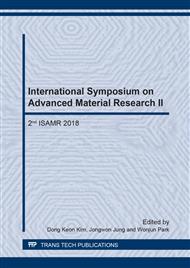[1]
Y. Funakawa, T. Shiozaki, and K. Tomita, et al., Development of high strength hot-rolled sheet steel consisting of ferrite and nanometer-sized carbides. ISIJ Int. 44 (2004) 1945-(1951).
DOI: 10.2355/isijinternational.44.1945
Google Scholar
[2]
Y. Funakawa, T. Fujita, and K. Yamada, Metallurgical features of Nanohiten™ and application to warm stamping. (2013) 74-79.
Google Scholar
[3]
C. Y. Chen, H. Yen, and F. Kao, et al., Precipitation hardening of high-strength low-alloy steels by nanometer-sized carbides. Mater. Sci. Eng. A 499 (2009) 162-166.
DOI: 10.1016/j.msea.2007.11.110
Google Scholar
[4]
X. G. Duan, Q. W. Cai, and H. B. Wu, Ti-Mo ferrite matrix micro-alloy steel with nanometer-sized precipitates. Acta Metall. Sin. 47 (2011) 251-256.
Google Scholar
[5]
B. H. Hu, Q. W. Cai, and H. B. Wu, Effect of Mo on the amount of Ti(C, N) precipitated from austenite in Ti-Mo micro-alloy steel. J. Univ. Sci. Technol. B. 35 (2013) 481-488.
Google Scholar
[6]
J. H. Jang, C. Lee, and Y. Heo, et al., Stability of (Ti, M) C (M= Nb, V, Mo and W) carbide in steels using first-principles calculations. Acta Mater. 60 (2012) 208-217.
DOI: 10.1016/j.actamat.2011.09.051
Google Scholar
[7]
Q. L. Yong, Secondary Phase in Steel, Metallurgical Industry Press, Beijing, (2006).
Google Scholar
[8]
C. F. Sun, Q. W. Cai, and H. B. Wu, et al., Effect of controlled rolling processing on nanometer-sized carbonitride of Ti-Mo ferrite matrix microalloyed steel. Acta Metall. Sin. 48 (2012) 1415-1421.
DOI: 10.3724/sp.j.1037.2012.00348
Google Scholar
[9]
X. G. Duan, Q. W. Cai, and W. H. Bin, et al., Precipitation law of ultra fine carbides in ferrite matrix Ti-Mo micro-alloy steel. J. Univ. Sci. Technol. B. 34 (2012) 644-650.
Google Scholar
[10]
L. Zhang, C. X. Xue, and W. Y. Yang, et al., Quantitative investigation of deformation induced precipitation in coarse grained austenite HTP steel. Acta Metall. Sin. 43 (2007) 791-796.
Google Scholar
[11]
K. A. Taylor, Solubility products for titanium-, vanadium-, and niobium-carbide in ferrite. Scripta Metal. Mater. 32 (1995) 7-12.
DOI: 10.1016/s0956-716x(99)80002-8
Google Scholar
[12]
S. Yamamoto, C. Ouchi, and T. Osuka, The effect of microalloying elements on the recovery and recrystallization in deformed austenite. Thermomechanical Processing of Microalloyed Austenite (1981) 613-639.
Google Scholar
[13]
Q. Yong, Physical Metallurgical Data of Titanium in Steels. J. Yunnan Polytech. Univ (1999).
Google Scholar
[14]
Q. L. Yong, M. X. Chen, and H. Z. Pei, et al., Theoretical Calculation for PTT Curve of Microalloy Carbonitride Precipitated in Ferrite. J. Iron Steel Res. Int. 18 (2006) 25, 30-32.
Google Scholar
[15]
S. Okaguchi, and T. Hashimoto, Computer model for prediction of carbonitride precipitation during hot working in Nb-Ti bearing HSLA steels. ISIJ Int. 32 (1992) 283-290.
DOI: 10.2355/isijinternational.32.283
Google Scholar


